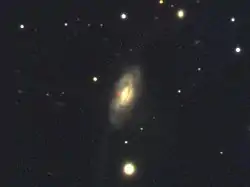| Arp 187 | |
|---|---|
 Arp 187 by PanSTARRS | |
| Observation data (J2000 epoch) | |
| Constellation | Eridanus |
| Right ascension | 5h 03m 53s [1] |
| Declination | −10° 14′ 51″ [1] |
| Redshift | 12095 ± 45 km/s [1] |
| Apparent magnitude (V) | 15.3 [1] |
| Characteristics | |
| Type | Radio Galaxy [1] |
| Apparent size (V) | 0.8 x 0.6 [1] |
| Other designations | |
| PGC 16691 [1] | |
Arp 187 is a radio galaxy and merger remnant located in the constellation Eridanus. It is an interacting galaxy pair (MCG-02-13-040).[2] It is included in the Atlas of Peculiar Galaxies in the category galaxies with narrow filaments.
The galaxy has two prominent radio lobes, however the emission of its AGN in X-ray is low, and so is the thermal output of the AGN torus as observed in infrared, suggesting that it has been quenched. The detection of a narrow line region (with dimensions up to 10 kpc) with still active emission mean that the AGN was still active up to at least 104-5 years ago. In the nucleus of Arp 187 is predicted to lie a supermassive black hole (SMBH) with estimated mass around 6.7 × 108 M☉.[3] Further observations of such a SMBH with a quenched AGN were published in 2019.[4][5][6]
References
- 1 2 3 4 5 6 7 "NASA/IPAC Extragalactic Database". Results for Arp 187. Retrieved 2006-10-26.
- ↑ "Simbad". Retrieved 2010-01-06.
- ↑ Ichikawa, Kohei; Ueda, Junko; Shidatsu, Megumi; Kawamuro, Taiki; Matsuoka, Kenta (1 February 2016). "Signs of active galactic nucleus quenching in a merger remnant with radio jets". Publications of the Astronomical Society of Japan. 68 (1): 9. arXiv:1510.06037. doi:10.1093/pasj/psv112.
- ↑ "Active Galactic Nucleus caught in the act of "dying" 〜light echo delivers the information before the death〜". Tohoku university. 1 April 2019.
- ↑ Ichikawa K, Ueda J, Bae H, et al. (9 January 2019). "Discovery of Dying Active Galactic Nucleus in Arp 187: Experience of Drastic Luminosity Decline within 104 yr". The Astrophysical Journal. 870 (2): 65. arXiv:1811.07447. Bibcode:2019ApJ...870...65I. doi:10.3847/1538-4357/aaf233. S2CID 119466692.
- ↑ "Discovery of a Dying Supermassive Black Hole Via a 3000-year-long Light Echo". Tohoku university. 4 June 2021.
External links
- Arp 187 on WikiSky: DSS2, SDSS, GALEX, IRAS, Hydrogen α, X-Ray, Astrophoto, Sky Map, Articles and images
- Photo of Arp 187